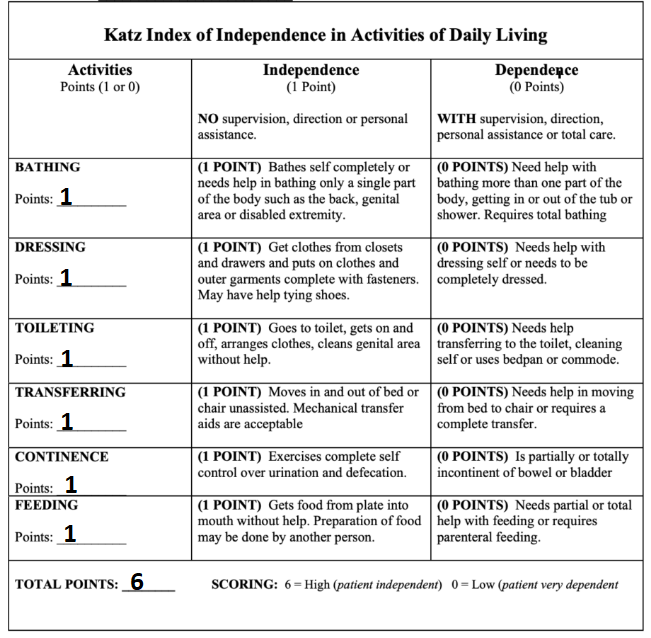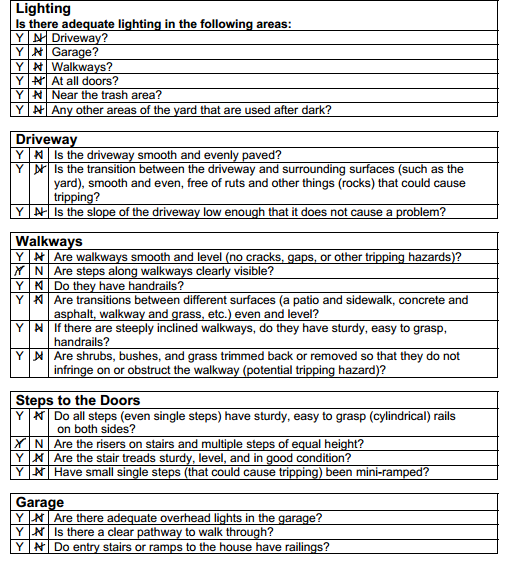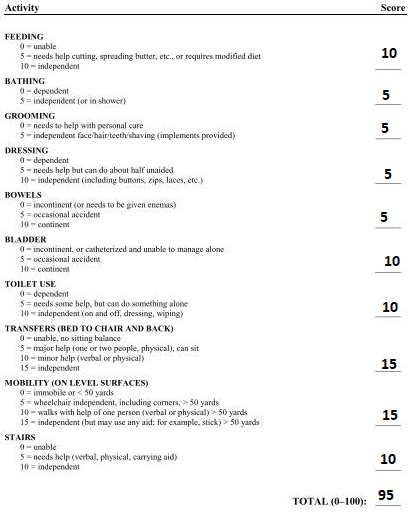As a summary of the patient’s psychosocial interview, emphasis can be placed on the point that he is not a classic case of an elderly care client. John prefers to act independently, has an excellent psychological and physiological condition, and seeks medical help only when necessary. The results of the physical and mental functional assessment will be presented further.
Physical and Mental Functional Assessment: Tinetti Balance and Gait Evaluation
The gait and balance assessment results show good results for the patient and a low risk. No significant age-related deterioration was found on almost all items (Figure 1).

Katz Index of Activities of Daily Living
The older adult under observation has no observable problems in daily living activities at this time (Figure 2; Pashmdarfard & Azad, 2020).

Assessment of Home Safety
The observed elderly person has reached a reasonable level in terms of home space optimization. For himself and his wife, the patient has organized his living and interior space efficiently (Figure 3).

The Barthel Index
The Barthel Index is based on interviews with the patient, his relatives, and observation (Bouwstra et al., 2019). The results for the observed age are quite high, though with some downward tendency (Figure 4).

Preliminary Issues
The changes associated with the aging process are identified as having standard deviations within acceptable limits. The main problems are delayed reactions, impaired coordination, impaired hearing, progressive visual impairment, and arthritis.
Alterations in Health
- A thorough examination of the patient’s joints is necessary to identify potential problems.
- Recommend further ophthalmologic evaluation and prescription of glasses – signs of visual impairment and slight disorientation are noted.
- Among other things, supplementation with special vitamin supplements for the elderly is recommended for maintaining a healthy body.
Comprehensive Interventions for Each Alteration
- In the case of problems with the knee joint, surgery may be necessary, after which the patient should be given a cane.
- Temporary walking with an assistive device will be recommended to reduce the joint load, even without surgery.
- Increased calcium and other essential nutrients may be recommended.
- Decrease in the physical activity for the period of health evaluation.
- Prescription of glasses for progressive hyperopia.
- Exercise to maintain vision at an adequate level.
- The patient should be encouraged to reduce the strain on vision.
- Reducing physical activity.
- Switching to a special set of exercises instead of the general one not intended for the elderly.
- Reconsideration of the entire diet in order to decrease the burden on the body.
Cultural Considerations
No additional cultural considerations are needed when recommending a patient. He demonstrates a remarkable high and responsive level of mental flexibility and listens to recommendations while prejudice is not noticed. However, given the firmness of character and some stubbornness, it is recommended that when making changes in the patient’s diet or physical activity, the relatives be asked to monitor compliance.
Summary
The patient is very self-confident and is accustomed to not showing weakness. Despite the shortness of breath and visual signs of aging, his mental state is in satisfactory condition. Food preferences and physical activity confirm the excellent condition of the body for this age.
Contrast of client’s responses with findings in current literature:
- He does not exaggerate his illnesses and does not try to evoke pity, which may often be noticed among patients of his age (Kim et al., 2021)
- Prefers the company of young people (Anwari et al., 2022)
- The patient has a good Body Mass Index: 25 kg/m2 (Naczk et al., 2020).
References
Anwari, C., Balasubramanian, S., Sawant, P., Kuri, U., Anand, A., Rao, B. C., & Prasad, R. (2022). Elder care: The need for interprofessional collaboration between Family Physicians, Clinical Pharmacists, and Physiotherapists in home-based primary care teams. Journal of Family Medicine and Primary Care, 11(9), 5170. Web.
Bouwstra, H., Smit, E. B., Wattel, E. M., van der Wouden, J. C., Hertogh, C. M. P. M., Terluin, B., & Terwee, C. B. (2019). Measurement properties of the Barthel index in geriatric rehabilitation. Journal of the American Medical Directors Association, 20(4), 420-425.e1. Web.
Kim, Han-Som, Choi, Seong-Youl, Lee, Hye-Sun, Han, & Sang-Woo. (2021). Development of a Korea-specific home safety assessment tool for the elderly. Annals of the Romanian Society for Cell Biology, 25(6), 20521–20539. Web.
Naczk, M., Marszalek, S., & Naczk, A. (2020). Inertial training improves strength, balance, and gait speed in elderly nursing home residents. Clinical Interventions in Aging, 15, 177–184. Web.
Pashmdarfard, M., & Azad, A. (2020). Assessment tools to evaluate Activities of Daily Living (ADL) and Instrumental Activities of Daily Living (IADL) in older adults: A systematic review. Medical Journal of the Islamic Republic of Iran, 34, 33. Web.